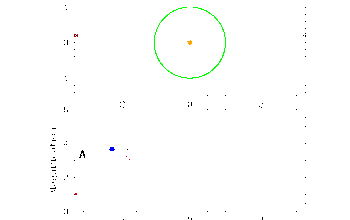Adaptive optics represents a profound leap in the evolution of astronomical instrumentation. This sophisticated technology empowers astronomers to effectively counteract the distorting effects of Earth’s atmosphere on astronomical observations. The intricacies of the cosmos juxtaposed against the fuzziness induced by atmospheric turbulence necessitate a resilient methodology to enhance celestial clarity. Thus, adaptive optics acts as a set of corrective lenses, meticulously calibrated to sharpen our vision of the universe.
To unravel the depths of this technology, it is crucial to comprehend its foundational principles. Generally, light emitted from distant celestial objects traverses the vastness of space only to encounter the volatile layers of Earth’s atmosphere. Here, fluctuations in temperature and density degrade the incoming light, an effect reminiscent of ripples on the surface of a pond. The result is a washed-out image—a smudge of points that entices yet frustrates the eager astrophysicist. Adaptive optics mitigates these atmospheric disturbances, allowing us to experience cosmic vistas with unparalleled precision.
At the heart of this technology lies the wavefront sensor, a pivotal instrument akin to an artist’s discerning eye. This sensor assesses the incoming light wavefronts to detect aberrations—distortions that taint the purity of cosmic images. Based on this analysis, a deformable mirror, which can alter its shape instantaneously, is employed to correct these imperfections. This feedback loop, whereby data on image quality is rapidly collected and corrective actions are enacted, signifies a substantial advancement in real-time astronomical analysis.
The implementation of adaptive optics has revolutionized our capacity to explore celestial phenomena. It has facilitated high-resolution imaging of celestial bodies, allowing us to delve deeper into the composition of star clusters, examine the intricate nebulae that cradle young stars, and scrutinize the structural dynamics of galaxies. Such precision was previously the realm of theoretical speculation; with adaptive optics, it has become tangible reality.
A particularly captivating application of adaptive optics is its role in the observation of exoplanets, planets residing outside our solar system. The challenge, akin to spotting a firefly amidst a stadium full of bright lights, requires extraordinary finesse. With adaptive optics, astronomers can distinguish the faint light of these alien worlds from the overwhelming glare of their host stars. Consequently, adaptive optics functions not only as a tool of enhancement but also as an agent of discovery in our ongoing quest to understand the myriad forms of existence beyond our own planet.
Another domain where adaptive optics has begun to flourish is in the intricate tapestry of stellar astrophysics. Observing the surfaces of distant stars, particularly during active phases like solar flares, reveals critical information about their magnetic fields and behavior. The ability to discern such dynamism from a great distance grants scientists a clearer view into the complexities of stellar evolution, positing new questions about the life cycles of stars across the universe.
Beyond mere observation, the synergy between adaptive optics and advancements in computational algorithms has opened new frontiers in data analysis. The capability to reconstruct images from the corrupted light received through the atmosphere allows for a deeper exploration of event horizons, black holes, and other enigmatic celestial occurrences. In many cases, these processed images yield insights that were previously unattainable, illustrating the profound interpretative power bestowed by adaptive technologies.
However, despite its merits, the implementation of adaptive optics is not without challenges. The systems are often complex and require meticulous calibration and maintenance. Moreover, the cost implications for educational institutions and research organizations pose significant barriers. Consequently, there is a continuous need for innovation within the realm of optics and device engineering to make these technologies more accessible.
Within the broader context of space exploration, adaptive optics is not confined to Earth-based observatories. The advent of space telescopes equipped with adaptive systems heralds a new era of astronomical observation. By transgressing the atmospheric interface altogether, these instruments promise images of celestial phenomena unmarred by terrestrial fluctuations. This astro-gaze from above the clouds redefines our approach to cosmic questions, permitting us to proffer hypotheses grounded in the pristine visual fidelity that adaptive optics cultivates.
Theoretically, the implications of enhancing our observational capabilities extend beyond our immediate gazes into the night sky. As adaptive optics becomes more refined, it opens doors to collaborative endeavors beyond our planet, such as preparing for missions to distant exoplanets and understanding the conditions that may foster life elsewhere in the universe. The quest for astrobiological signatures remains fiercely alive, prompting the need for heightened vigilance and clarity in our observing methods.
In sum, adaptive optics stands as a monumental advance in our pursuit of cosmological knowledge—a clarion call to sharpen our vision of the universe. This technology not only amplifies our ability to observe the cosmos with awe-inspiring clarity but also beckons us to engage with the questions it raises. With the promise of clearer skies above and the inexorable curiosity that pushes the boundaries of human understanding, adaptive optics encapsulates a pivotal juncture in our ongoing dialogue with the universe.
As we cultivate our cosmic vision through the lens of adaptive optics, we reignite humanity’s age-old fascination with the heavens. Sharpening our perspective, we find ourselves not just as passive observers of the celestial dance, but as active participants in the quest for knowledge that has perpetually driven our species beyond the confines of Earth. Thus, in looking towards the stars, the sky transforms from a mere backdrop to the grand stage of inquiry, illuminating the path forward in our enduring quest for understanding.











